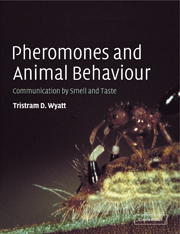Book contents
- Frontmatter
- Contents
- Preface
- Acknowledgements
- 1 Animals in a chemical world
- 2 Discovering pheromones
- 3 Sex pheromones: finding and choosing mates
- 4 Coming together and keeping apart: aggregation and host-marking pheromones
- 5 Scent marking and territorial behaviour
- 6 Pheromones and social organisation
- 7 Pheromones and recruitment communication
- 8 Fight or flight: alarm pheromones
- 9 Perception and action of pheromones: from receptor molecules to brains and behaviour
- 10 Finding the source: pheromones and orientation behaviour
- 11 Breaking the code: illicit signallers and receivers of semiochemical signals
- 12 Using pheromones: applications
- 13 On the scent of human attraction: human pheromones?
- Appendix A1 An introduction to pheromones for non-chemists
- Appendix A2 Isomers and pheromones
- Appendix A3 Further reading on pheromone chemical structure
- References
- List of credits
- Index
12 - Using pheromones: applications
Published online by Cambridge University Press: 03 December 2009
- Frontmatter
- Contents
- Preface
- Acknowledgements
- 1 Animals in a chemical world
- 2 Discovering pheromones
- 3 Sex pheromones: finding and choosing mates
- 4 Coming together and keeping apart: aggregation and host-marking pheromones
- 5 Scent marking and territorial behaviour
- 6 Pheromones and social organisation
- 7 Pheromones and recruitment communication
- 8 Fight or flight: alarm pheromones
- 9 Perception and action of pheromones: from receptor molecules to brains and behaviour
- 10 Finding the source: pheromones and orientation behaviour
- 11 Breaking the code: illicit signallers and receivers of semiochemical signals
- 12 Using pheromones: applications
- 13 On the scent of human attraction: human pheromones?
- Appendix A1 An introduction to pheromones for non-chemists
- Appendix A2 Isomers and pheromones
- Appendix A3 Further reading on pheromone chemical structure
- References
- List of credits
- Index
Summary
Introduction
The importance of pheromones in the natural behaviour of animals has long been recognised and, long before it was known what pheromones were, people used them to manipulate the behaviour of animals. For example, traditionally, shepherds have encouraged a ewe to adopt a strange lamb if her own died at birth, by covering the strange lamb with the skin of her dead lamb (see Chapter 9).
The clear potential for applied uses of pheromones was an early encouragement to research them. At the turn of the twentieth century and in its first few decades, the potential of synthetic chemical signals to control insect pests was anticipated in both North America and in Europe (Chapter 1) (see reviews by Hecker & Butenandt 1984, Roelofs 1995, Plarre 1998). There is now increasing use of pheromones to affect the behaviour of domesticated animals, from cows to bees, as well as use as ‘greener’ alternatives to pesticides, largely for the control of insect pests. However, no matter how elegant the science, pheromones will be exploited only if they are commercially viable (Winston 1997). In this chapter I will concentrate on such examples, although I will also mention some promising leads. Human odours will be discussed in the next chapter (Chapter 13).
Pheromones used with beneficial and domestic animals
Reproduction of farm animals
Both priming and signalling effects of sex pheromones are used for the manipulation of reproductive behaviour in domestic mammals (Izard 1983; Booth & Signoret 1992; Houpt 1998). Modern farming practices, including isolation of the sexes, crowding and artificial insemination (AI), may block pheromone mechanisms evolved before domestication (Izard 1983).
- Type
- Chapter
- Information
- Pheromones and Animal BehaviourCommunication by Smell and Taste, pp. 251 - 269Publisher: Cambridge University PressPrint publication year: 2003



